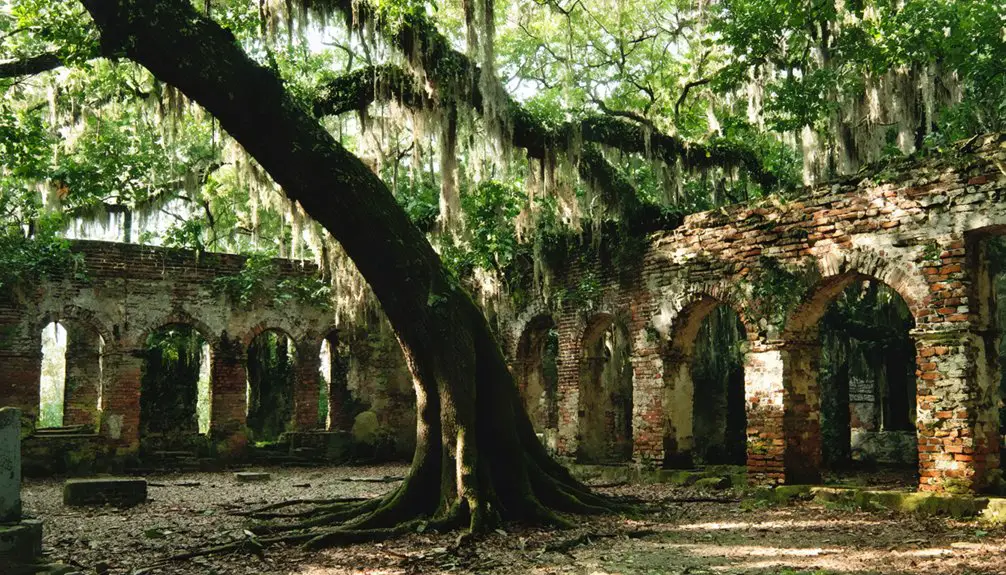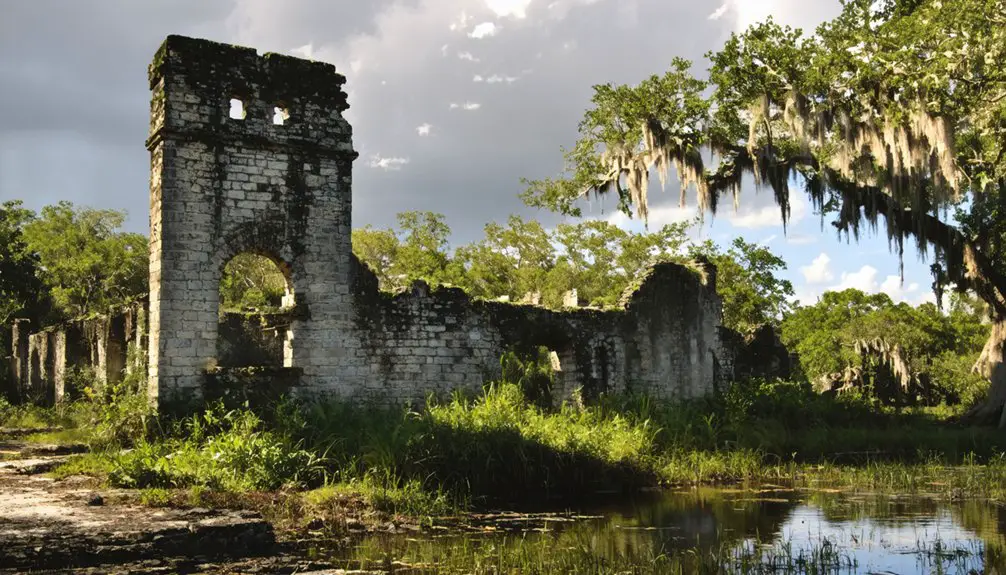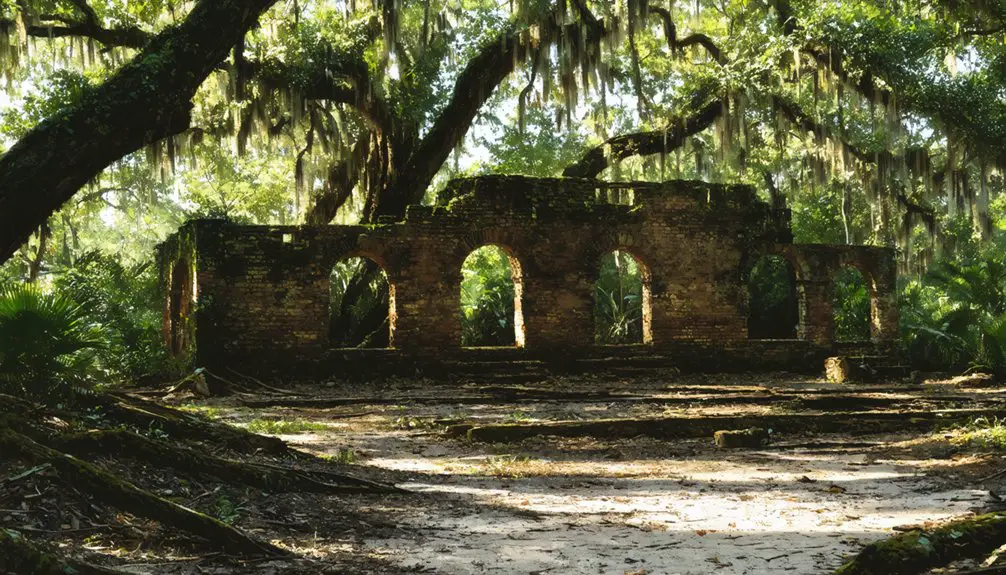You’ll find Rollestown as a fascinating ghost town established in 1767 along Florida’s St. Johns River during British colonial rule. Founded by Denys Rolle, a former Member of Parliament, this 20,000-acre settlement aimed to create an agricultural refuge for London’s disadvantaged through innovative labor practices and diverse crop production. The settlement faced numerous challenges with its workforce before ultimately relocating to the Bahamas in 1783. The site’s complex history offers deeper insights into colonial East Florida‘s social experiments.
Key Takeaways
- Rollestown was established in 1767 by Denys Rolle as a 20,000-acre settlement along the St. Johns River in East Florida.
- The settlement initially housed London’s disadvantaged as indentured servants but later transitioned to enslaved African workers.
- Rollestown featured diverse agricultural production, including citrus, cattle ranching, naval stores, beer, and orange juice.
- The settlement was abandoned in 1783 when Florida was ceded to Spain, with inhabitants relocating to the Bahamas.
- British architectural elements, including sash-windowed buildings and a church, marked Rollestown’s colonial influence before becoming a ghost town.
Origins Under British Colonial Rule
When Britain gained control of Florida through the 1763 Treaty of Paris, the colonial administration launched an ambitious settlement program that gave birth to Rollestown in 1767.
You’ll find that colonial governance was remarkably hands-off, with minimal British staff and just one regiment of soldiers protecting the settlers.
The administration divided Florida into East and West colonies at the Apalachicola River, offering generous land grants up to 20,000 acres to encourage colonization.
Settler experiences varied dramatically, as Denys Rolle brought roughly 200 indentured servants from London’s marginalized populations – including vagrants, beggars, debtors, and prostitutes – to establish his vision of an agricultural utopia. The settlement later brought in Negro slaves to work in cattle and citrus operations.
The settlement was originally named Charlotta, after Rolle’s mother, before being changed to Rollestown.
To secure your grant, you’d need to develop the land within ten years, receiving 100 acres per settler and 50 per family member.
Vision and Ambitions of Denys Rolle
Though many colonial ventures focused purely on profit, Denys Rolle’s vision for Rollestown centered on creating an ideal agricultural society that would offer refuge and opportunity to London’s disadvantaged populations.
His philanthropic ideals drove him to establish a 20,000-acre settlement where vagrants, beggars, debtors, and prostitutes could build new lives through farming and labor. As a former Member of Parliament for Barnstaple, he leveraged his political connections to support his colonial endeavors.
Known for his modest and puritanical nature, Rolle strictly regulated activities he deemed immoral in his settlement.
Rolle’s agricultural ambitions included developing citrus crops, cattle ranching, and naval stores production.
You’ll find his vision went beyond mere economic gains – he genuinely sought to transform society’s outcasts into productive colonists.
As a wealthy landowner from Devon, he invested heavily in this “Peace and Plenty” enterprise, believing that organized land and labor could reform the disadvantaged while creating a self-sustaining colonial economy.
Daily Life in the Settlement
As Rollestown developed along the St. Johns River, you’d find a hierarchical community centered around a cypress mansion house where daily routines revolved around plantation agriculture.
The settlement’s workforce initially consisted of indentured servants, many former criminals from England and the Carolinas, later replaced by enslaved Africans.
Community dynamics were shaped by distinct social roles, with overseers and skilled craftsmen like blacksmiths living in separate dwellings near their workplaces.
You’d witness the constant hum of essential activities – field labor, tool maintenance, and food production.
The isolated location and demanding work schedule limited social interactions, while tensions between servants, slaves, and management often led to desertions.
Over time, declining conditions of both buildings and productivity weakened the settlement’s stability.
The early settlers relied heavily on ferry service across the St. Johns River to transport goods and people.
The plantation produced valuable commodities including naval stores, beef, and citrus products.
Labor Challenges and Workforce Evolution
The story of Rollestown’s workforce reveals a stark contrast between utopian vision and harsh reality. When Denys Rolle established the settlement in 1767, he brought 200 indentured servants from London’s marginalized populations, hoping to create a haven of “Peace and Plenty.”
However, these laborers, primarily vagrants and debtors, lacked the agricultural skills needed for workforce adaptation in Florida’s challenging environment. As labor efficiency plummeted due to desertion and incompetence, Rolle abandoned his philanthropic experiment and shifted to enslaved African workers. The tropical wilderness environment proved particularly difficult for European settlers to navigate. Much like the challenges of navigation in Rollestown, modern visitors often need proper disambiguation to locate historical information about the settlement.
This new workforce proved more capable of handling the demanding tasks of citrus cultivation, turpentine production, and cattle raising. The settlement’s demographic composition shifted dramatically until its eventual abandonment in 1783, when Britain ceded Florida to Spain.
Native American Relations and Treaties
During Rollestown’s existence, relations with Native Americans centered primarily around the Seminole tribe, whose presence would later shape Florida’s territorial development through a series of contentious treaties.
Spanish Florida’s policy of providing refuge to runaway slaves intensified tensions between settlers and Seminoles.
The 1823 Treaty of Moultrie Creek established a four-million-acre reservation in central Florida, requiring Seminoles to give up their remaining lands and restrict contact with outside traders. Governor Duval permitted fishing along the Gulf coast in 1827 due to severe food shortages.
You’ll find that despite U.S. promises of protection and provisions, mounting pressure for complete removal led to fierce Native resistance.
The Seminole treaties, particularly the 1832 Treaty of Payne’s Landing, forced relocation to Oklahoma, but 200-300 Seminoles refused to leave Florida.
Their resistance through three wars ultimately influenced U.S. policy, as they adapted to life in the Everglades rather than submit to complete removal.
Geographic Significance Along St. Johns River
Located at a strategic bend of the St. Johns River, Rollestown’s position marked an essential shift point between deep and shallow waters.
You’ll find this former settlement at the head of deepwater river navigation, where larger vessels from Jacksonville could reach before the waterway became too shallow for heavy cargo transport.
The site’s geographic advantage made it an economic hub, particularly given its massive 78,000-acre plantation with direct river access.
You’re looking at what was once a significant transfer point for goods and passengers, positioned perfectly on the east bank across from Palatka.
The Seminoles called this narrow section “Pilotaikita,” meaning “crossing over,” highlighting its natural ford.
The fertile soil and irrigation from the river supported extensive agriculture, while the deepwater access guaranteed efficient transport of products to downstream markets.
Transition From Servants to Slavery

You’ll find that Rollestown’s early labor force of 200 white indentured servants from London quickly proved inadequate, as these unskilled workers struggled with the tropical climate and fled in large numbers.
The plantation’s shift to enslaved African labor began in the late 1760s, growing from 22 slaves in 1768 to 138 by 1783, providing a more stable workforce for agricultural and industrial operations.
This enslaved population ultimately relocated with Denys Rolles to the Bahamas when Britain ceded Florida to Spain, though 42 slaves perished during this difficult shift.
Labor Force Early Challenges
While most British Florida settlements relied heavily on enslaved African labor, Rollestown and Smyrnéa stood apart by initially employing white indentured servants as their primary workforce.
You’ll find that harsh labor conditions and high indentured mortality rates eventually undermined this alternative labor model.
The key challenges that plagued Rollestown’s early labor force included:
- Widespread disease outbreaks and inadequate provisions of food and clothing
- Frequent desertion by indentured servants due to harsh treatment from overseers
- Ongoing security concerns from potential Indian hostilities
Despite Denys Rolle’s vision of creating a self-sufficient plantation economy through naval stores and orange juice production, these workforce difficulties severely hampered the settlement’s development.
The mounting challenges ultimately pushed Rollestown toward the regional trend of shifting to enslaved African labor, reflecting broader changes in British colonial labor patterns.
Slave Population Growth Pattern
Three distinct phases marked Rollestown’s shift from indentured servitude to enslaved labor between 1767-1783.
Initially, Denys Rolles brought white indentured servants from London, primarily vagrants and debtors, who proved unsuitable for tropical agriculture.
In the second phase, you’ll find the plantation evolving to enslaved African labor as the original workforce departed for other colonies.
The final phase saw the enslaved demographics expand considerably across 20,000 acres to support multiple enterprises.
The plantation economy grew to include 14 enslaved people living in six cabins, maintaining 100 head of cattle on 1,400 acres under Job Wiggins’ ownership.
You’ll note that enslaved workers became essential to Rollestown’s agricultural success, managing cotton, indigo, citrus, and turpentine production for European markets – reflecting the broader pattern of Southeastern plantations.
Bahamas Migration Impact
Deep-rooted economic changes in the Bahamas profoundly shaped migration patterns and labor shifts during the pre-emancipation period.
You’ll find that white mercantile elites maintained control through credit systems and trade monopolies, forcing workers into cycles of debt and dependency. This economic resistance through migration became an essential survival strategy for working-class Bahamians seeking to escape oppressive conditions.
Key aspects of this shift included:
- Change from traditional plantation slavery to coercive credit and truck systems
- Migration to Key West and Miami as a means of avoiding debt bondage
- Development of merchant-controlled economic structures that created “practical slavery”
The collapse of the cotton plantation system and subsequent economic restructuring pushed many Bahamians to seek opportunities elsewhere, greatly impacting labor demographics in nearby U.S. ports.
The Great Exodus to the Bahamas

When Britain ceded Florida back to Spain in 1783, Denys Rolle orchestrated a significant migration of his colony’s inhabitants to the Bahamas.
You’ll find that this exodus involved transporting slaves, livestock, and property aboard a scow named Peace and Plenty to Exuma Island.
Migration narratives reveal how Rolle established two new plantations: Rolleville and Steventon, continuing his agricultural enterprises with enslaved labor.
The relocation demonstrated remarkable cultural resilience, as the enslaved people maintained their community bonds despite forced displacement.
After Denys Rolle’s death in 1797, his son John inherited the plantations and the title Lord of Stevenstone.
This transfer of ownership would later prove significant, as John Rolle’s decision to give the land to his freed slaves following emancipation in 1834 shaped the region’s future demographics.
Historical Markers and Present-Day Location
If you’re looking for Rollestown’s historical marker today, you’ll find it within a wayside park owned by Florida Power & Light on the east side of the St. Johns River near State Road 17 in East Palatka.
The commemorative site, known locally as Rollestown Point, features no remaining colonial structures but serves as an educational stopping point along the highway.
The marker details Denys Rolle’s 1767 settlement experiment and the subsequent shift from indentured servants to enslaved laborers before the colony’s ultimate abandonment in 1783.
Location of Memorial Marker
Located at 343 US-17 in East Palatka, Florida, the Rollestown memorial marker stands in a serene wayside park owned by Florida Power & Light.
You’ll find the marker positioned along the east bank of the St. Johns River, just south of Palatka on State Road 17, where free parking guarantees convenient marker accessibility for your visit.
The site offers several key visitor amenities:
- Well-maintained grounds surrounded by lush Florida greenery
- Unobstructed views of the historic St. Johns River
- Ample parking space for vehicles of all sizes
You can easily spot the marker from the highway as you travel along US-17.
While no structural remains exist from the original settlement, the marker’s strategic placement provides an ideal vantage point for understanding the historical significance of Rollestown’s location.
Commemorative Site Details Today
While no original structures remain at this historical preservation site, the location maintains its relevance as a demonstration to colonial British Florida.
The marker recounts the settlement’s shift from indentured servants to slave labor, and its ultimate abandonment in 1783.
The site offers year-round accessibility and serves as an educational landmark highlighting early American settlement challenges.
Historic Highway Signage Placement
Today’s visitors can find the Rollestown historical marker in a peaceful wayside park along State Road 17, just south of Palatka on the St. Johns River’s east side.
The marker’s strategic placement offers both historical context and easy accessibility, positioned to capture attention from passing travelers while maintaining geographic authenticity to the original settlement site.
When you visit the marker, you’ll discover:
- Detailed information about Denys Rolle’s 1767 utopian settlement during British Florida
- Chronicles of the colony’s evolution from indentured servants to enslaved African workers
- Documentation of the settlement’s ultimate abandonment in 1783
The visitor experience includes natural surroundings with lush greenery, creating an ideal setting for reflecting on this significant piece of Northeast Florida’s colonial history.
Cultural Impact in the British Colonial Era
As a unique experiment in British colonial settlement, Rollestown’s cultural legacy derived from its departure from typical plantation labor systems in East Florida.
You’ll find that while neighboring plantations relied heavily on enslaved Black labor, Rollestown fostered a distinctive cultural exchange through its use of white indentured servants who worked toward land ownership. This created a more egalitarian colonial society, though still within British hierarchical structures.
In contrast to the region’s standard agricultural focus, you’ll discover Rollestown’s diverse production included beer, orange juice, and naval stores.
The settlement’s built environment reflected British cultural aspirations, featuring sash-windowed architecture and a church.
Though ultimately unsuccessful, Rollestown’s attempt at a more equitable labor system challenged the dominant plantation culture of colonial East Florida.
Frequently Asked Questions
What Crops Were Primarily Grown at Rollestown During Its Active Years?
Like a flourishing Southern oasis, you’d find crops dominated by citrus orchards, particularly oranges. The agricultural practices also included turpentine production from pine trees, showing limited crop diversity beyond cattle ranching.
Did Any Original Structures or Buildings From Rollestown Survive to Modern Times?
You won’t find any architectural remnants from Rollestown today – historical preservation wasn’t possible as all original structures, including Denys Roll’s mansion, have completely vanished over the centuries since its abandonment.
What Was the Average Temperature and Climate Like in Rollestown?
Ever wonder about life in subtropical Florida? You’d have experienced climate patterns ranging from mild winters in the mid-60s°F to sweltering summers in the low-90s°F, with temperature fluctuations averaging around 75°F annually.
How Did Denys Rolle Communicate With and Manage the Settlement From England?
You’ll find Rolle managed through letters sent by ship, which took months to arrive. He relied on local agents and overseers, facing significant long distance communication and management challenges requiring constant written correspondence.
Were There Any Notable Conflicts Between Rollestown Settlers and Neighboring Settlements?
You’d expect settler disputes between rival colonies, but surprisingly, there’s no documented evidence of neighboring tensions at Rollestown. The settlement’s own internal problems and eventual abandonment overshadowed potential external conflicts.
References
- https://historiccity.com/2010/staugustine/news/historic-city-memories-ghost-towns-2510
- https://www.florida-backroads-travel.com/florida-ghost-towns.html
- https://myfloridahistory.org/frontiers/article/188
- https://www.ghosttowns.com/states/fl/rollestown.html
- https://www.hmdb.org/m.asp?m=56656
- https://www.waymarking.com/waymarks/WMJ2W_Rollestown
- https://stars.library.ucf.edu/cgi/viewcontent.cgi?article=1776&context=fhq
- https://floridahistory.org/british.htm
- https://en.wikipedia.org/wiki/Denys_Rolle_(died_1797)
- https://kids.kiddle.co/Denys_Rolle_(died_1797)



